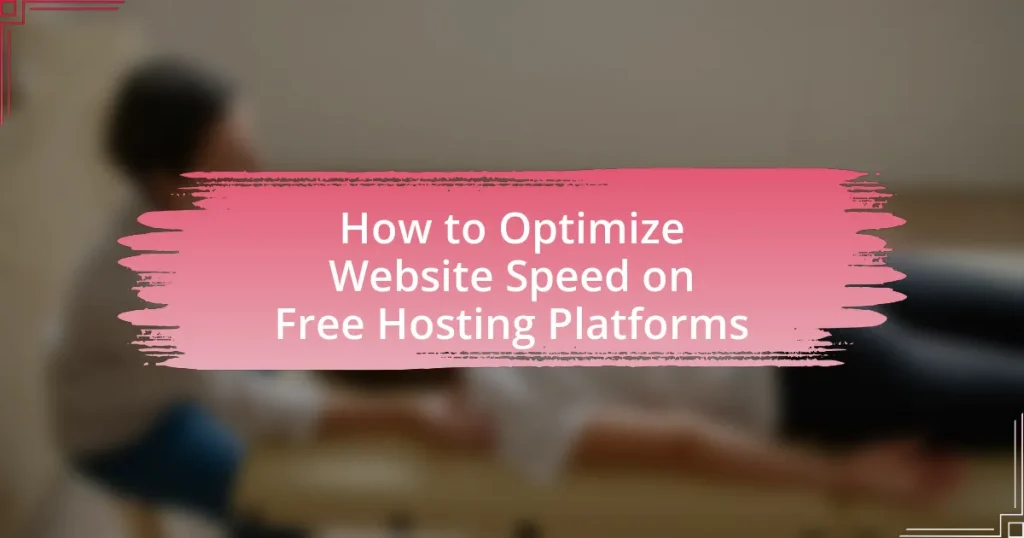Website speed optimization on free hosting platforms is essential for enhancing loading speed and overall performance, as these services often come with limitations that can negatively affect user experience and search engine rankings. Key strategies for optimization include minimizing file sizes, leveraging browser caching, optimizing images, and reducing HTTP requests. The article discusses the importance of website speed for user engagement, its impact on bounce rates and SEO rankings, and the challenges posed by free hosting platforms. Additionally, it outlines tools for measuring speed, techniques for improvement, and best practices for maintaining optimal performance.

What is Website Speed Optimization on Free Hosting Platforms?
Website speed optimization on free hosting platforms involves techniques to enhance the loading speed and performance of websites hosted on these services. This optimization is crucial because free hosting often comes with limitations such as slower server response times and bandwidth restrictions, which can negatively impact user experience and search engine rankings. Effective strategies include minimizing file sizes through compression, leveraging browser caching, optimizing images, and reducing the number of HTTP requests. Studies show that a one-second delay in page load time can lead to a 7% reduction in conversions, highlighting the importance of speed optimization for maintaining user engagement and satisfaction.
Why is website speed important for user experience?
Website speed is crucial for user experience because it directly impacts user satisfaction and engagement. Research indicates that a one-second delay in page load time can lead to a 7% reduction in conversions, highlighting the importance of speed in retaining users. Additionally, Google reports that 53% of mobile users abandon sites that take longer than three seconds to load, demonstrating that slow websites can significantly increase bounce rates. Therefore, optimizing website speed is essential for maintaining user interest and improving overall site performance.
How does website speed impact bounce rates?
Website speed significantly impacts bounce rates, as slower loading times lead to higher abandonment rates. Research indicates that 40% of users abandon a website that takes more than three seconds to load, highlighting the direct correlation between speed and user retention. Additionally, Google reports that a one-second delay in mobile page load time can decrease conversions by up to 20%. Therefore, optimizing website speed is crucial for reducing bounce rates and improving overall user engagement.
What role does website speed play in SEO rankings?
Website speed significantly impacts SEO rankings, as search engines prioritize fast-loading sites to enhance user experience. Research by Google indicates that a one-second delay in page load time can lead to a 20% decrease in conversion rates, highlighting the importance of speed in retaining visitors. Additionally, Google’s Core Web Vitals, which include loading performance metrics, are critical ranking factors, further emphasizing that faster websites are more likely to achieve higher positions in search results.
What challenges do free hosting platforms present for website speed?
Free hosting platforms often present significant challenges for website speed due to limited server resources, bandwidth restrictions, and shared hosting environments. These platforms typically allocate minimal CPU and RAM to each user, which can lead to slower processing times and increased load times for websites. Additionally, bandwidth limitations can result in throttling during peak traffic periods, further degrading performance. Shared hosting means multiple websites compete for the same server resources, which can cause slowdowns, especially if one site experiences high traffic. Studies have shown that websites hosted on free platforms can load significantly slower than those on paid services, impacting user experience and search engine rankings.
How do resource limitations affect website performance?
Resource limitations significantly degrade website performance by restricting the availability of essential computing resources such as CPU, memory, and bandwidth. When a website operates on a free hosting platform, it often encounters constraints like limited server resources, which can lead to slower loading times, increased latency, and potential downtime during high traffic periods. For instance, a study by Google found that a one-second delay in loading time can lead to a 20% decrease in conversion rates, highlighting the critical impact of resource limitations on user experience and engagement.
What common issues arise with free hosting services?
Common issues that arise with free hosting services include limited bandwidth, lack of customer support, and frequent downtime. Limited bandwidth can lead to slow website loading times, especially during peak traffic periods, which negatively impacts user experience. The absence of reliable customer support means that users may struggle to resolve technical issues promptly, further affecting website performance. Additionally, frequent downtime can occur due to server overload or maintenance, resulting in reduced accessibility for visitors. These factors collectively hinder the optimization of website speed on free hosting platforms.

How can you measure website speed on free hosting platforms?
To measure website speed on free hosting platforms, utilize online tools such as Google PageSpeed Insights, GTmetrix, or Pingdom. These tools analyze various performance metrics, including load time, time to first byte, and overall user experience scores. For instance, Google PageSpeed Insights provides a detailed report on both mobile and desktop performance, offering suggestions for improvement based on real-world data. Using these tools allows users to effectively gauge their website’s speed and identify areas for optimization, ensuring a better experience for visitors.
What tools are available for testing website speed?
Tools available for testing website speed include Google PageSpeed Insights, GTmetrix, Pingdom, and WebPageTest. Google PageSpeed Insights analyzes the content of a web page and provides suggestions to make that page faster, scoring it based on performance metrics. GTmetrix combines Google Lighthouse and Web Vitals to offer insights into page load times and performance scores. Pingdom allows users to test website speed from multiple locations and provides detailed performance reports. WebPageTest offers advanced testing options, including the ability to simulate different devices and connection speeds. These tools are widely recognized for their effectiveness in measuring and optimizing website speed.
How do different tools compare in terms of features?
Different tools for optimizing website speed on free hosting platforms vary significantly in features. For instance, tools like Google PageSpeed Insights provide detailed performance metrics and suggestions for improvement, while GTmetrix offers comprehensive reports that include waterfall charts and historical data tracking. Additionally, tools such as Pingdom focus on user experience by providing real-time performance monitoring and alerts. Each tool’s unique features cater to different aspects of website optimization, such as load time analysis, resource management, and user experience enhancement, making it essential for users to choose based on their specific needs and goals.
What metrics should you focus on when measuring speed?
When measuring speed, focus on metrics such as Page Load Time, Time to First Byte (TTFB), and First Contentful Paint (FCP). Page Load Time indicates how long it takes for a webpage to fully load, which directly impacts user experience; studies show that a one-second delay can lead to a 7% reduction in conversions. Time to First Byte measures the responsiveness of a web server, with lower values indicating better performance; a TTFB of under 200 milliseconds is considered optimal. First Contentful Paint tracks the time it takes for the first piece of content to appear on the screen, with faster FCP times enhancing perceived performance. These metrics collectively provide a comprehensive view of website speed and user experience.
How can you analyze the results of your speed tests?
To analyze the results of your speed tests, compare the metrics obtained against industry benchmarks and your website’s previous performance. Key metrics to focus on include load time, time to first byte, and page size. For instance, a load time under three seconds is generally considered optimal for user experience. Use tools like Google PageSpeed Insights or GTmetrix to gather these metrics and identify areas for improvement. Analyzing trends over multiple tests can reveal patterns, such as peak usage times affecting speed, allowing for targeted optimizations.
What do the results indicate about your website’s performance?
The results indicate that your website’s performance is significantly impacted by factors such as loading speed, user engagement, and server response times. For instance, a website that loads in under three seconds typically sees a 32% increase in conversion rates, according to Google’s research. Additionally, high bounce rates often correlate with slow loading times, suggesting that users are less likely to stay on a site that takes too long to load. Therefore, optimizing these elements can lead to improved overall performance and user satisfaction.
How can you identify specific areas for improvement?
To identify specific areas for improvement in website speed on free hosting platforms, conduct a comprehensive performance analysis using tools like Google PageSpeed Insights or GTmetrix. These tools provide detailed reports on loading times, resource sizes, and suggestions for optimization. For instance, Google PageSpeed Insights evaluates various metrics such as First Contentful Paint and Time to Interactive, highlighting specific elements that slow down the site. By analyzing these metrics, you can pinpoint areas like image optimization, script minification, and server response times that require enhancement.

What strategies can you implement to optimize website speed on free hosting platforms?
To optimize website speed on free hosting platforms, implement strategies such as minimizing HTTP requests, optimizing images, and utilizing browser caching. Minimizing HTTP requests can be achieved by combining CSS and JavaScript files, which reduces the number of files the server must load. Optimizing images involves compressing them without losing quality, which can significantly decrease load times; tools like TinyPNG can reduce image sizes by up to 70%. Utilizing browser caching allows frequently accessed resources to be stored locally on users’ devices, decreasing load times for repeat visitors. According to Google, effective caching can improve load times by 60% or more.
How can you reduce image sizes without losing quality?
To reduce image sizes without losing quality, utilize image compression tools that maintain visual fidelity while decreasing file size. Tools like TinyPNG and JPEGmini apply lossless compression techniques, which optimize images by removing unnecessary data without affecting the quality perceived by the human eye. According to a study by Google, optimizing images can lead to a reduction in load times by up to 50%, significantly enhancing website speed and performance.
What tools can help with image optimization?
Tools that can help with image optimization include TinyPNG, ImageOptim, and Kraken.io. TinyPNG uses smart lossy compression techniques to reduce image file sizes without compromising quality, achieving up to 70% reduction in file size. ImageOptim is a Mac application that removes unnecessary metadata and compresses images effectively, making it ideal for web use. Kraken.io offers both a web interface and an API for bulk image optimization, supporting various formats and providing lossless and lossy compression options. These tools are widely recognized for their effectiveness in enhancing website speed by optimizing images, which is crucial for performance on free hosting platforms.
How does image optimization affect loading times?
Image optimization significantly reduces loading times by decreasing the file size of images without compromising quality. When images are optimized, they consume less bandwidth and load faster, which enhances user experience and improves website performance. For instance, studies show that optimized images can reduce loading times by up to 70%, leading to lower bounce rates and higher engagement. This is particularly crucial for websites on free hosting platforms, where resources may be limited.
What role does caching play in website speed optimization?
Caching significantly enhances website speed optimization by storing frequently accessed data temporarily, allowing for quicker retrieval. When a user visits a website, caching reduces the need to fetch data from the server repeatedly, which minimizes load times. For instance, studies show that implementing caching can improve page load speeds by up to 70%, as it decreases server response times and reduces bandwidth usage. This efficiency is crucial for maintaining user engagement and improving overall site performance, particularly on free hosting platforms where resources may be limited.
How can you implement caching on free hosting platforms?
You can implement caching on free hosting platforms by utilizing browser caching and leveraging Content Delivery Networks (CDNs). Browser caching allows static resources like images, CSS, and JavaScript files to be stored on users’ devices, reducing load times for subsequent visits. This can be configured by setting appropriate cache-control headers in your website’s .htaccess file or server settings. Additionally, using a CDN can distribute your content across multiple servers globally, enabling faster access for users by serving cached versions of your site from the nearest location. Many free hosting platforms support basic CDN integration, which can significantly enhance performance.
What types of caching are most effective for speed improvement?
The most effective types of caching for speed improvement are browser caching, server-side caching, and content delivery network (CDN) caching. Browser caching stores static resources like images and scripts on the user’s device, reducing load times for repeat visits. Server-side caching, such as object caching and page caching, minimizes database queries and speeds up content delivery by storing pre-rendered pages or frequently accessed data. CDN caching distributes content across multiple servers globally, allowing users to access data from the nearest location, which significantly reduces latency. These caching methods collectively enhance website performance, as evidenced by studies showing that effective caching can improve load times by up to 70%.
How can you minimize HTTP requests to enhance speed?
To minimize HTTP requests and enhance speed, combine multiple CSS and JavaScript files into single files. This approach reduces the number of requests made by the browser, as each file requires a separate HTTP request. For instance, using tools like Webpack or Gulp can automate the process of file concatenation, leading to fewer requests and faster loading times. Additionally, implementing CSS sprites for images can further decrease the number of requests by combining multiple images into one file, which is then displayed using CSS. This method is supported by studies indicating that reducing HTTP requests can significantly improve page load times, with a reduction of requests by even 50% often resulting in noticeable speed enhancements.
What techniques can be used to combine files?
Techniques to combine files include file concatenation, minification, and bundling. File concatenation involves merging multiple files into a single file to reduce the number of HTTP requests, which can enhance loading speed. Minification reduces file size by removing unnecessary characters, such as whitespace and comments, without affecting functionality, thereby improving load times. Bundling groups multiple files together, often used for JavaScript and CSS, to streamline the loading process. These techniques are essential for optimizing website speed, especially on free hosting platforms where resource limitations may exist.
How does reducing the number of plugins impact performance?
Reducing the number of plugins significantly enhances website performance by decreasing load times and resource consumption. Each plugin adds additional code and requests that the server must process, which can slow down page rendering. For instance, a study by Google found that reducing HTTP requests by just a few can lead to faster load times, improving user experience and SEO rankings. Furthermore, fewer plugins reduce the risk of conflicts and security vulnerabilities, which can also negatively impact performance. Therefore, minimizing plugins directly correlates with improved website efficiency and speed.

What are the best practices for maintaining website speed on free hosting platforms?
To maintain website speed on free hosting platforms, optimize images and minimize file sizes. Large images can significantly slow down loading times; therefore, using formats like WebP and compressing images can enhance performance. Additionally, leveraging browser caching allows frequently accessed resources to be stored locally, reducing load times for returning visitors. Implementing a Content Delivery Network (CDN) can also improve speed by distributing content across multiple servers closer to users. Furthermore, minimizing HTTP requests by combining CSS and JavaScript files reduces the number of requests made to the server, which is crucial on free hosting platforms with limited resources. Lastly, regularly monitoring website performance using tools like Google PageSpeed Insights can help identify and address speed issues promptly.
How often should you review and optimize your website speed?
You should review and optimize your website speed at least once every three months. Regular assessments are crucial because website performance can fluctuate due to various factors such as increased traffic, changes in content, or updates to plugins and themes. According to Google, a loading time of over three seconds can lead to a 40% increase in bounce rates, emphasizing the importance of maintaining optimal speed. Additionally, tools like Google PageSpeed Insights and GTmetrix can provide insights into performance metrics, helping to identify areas for improvement during these reviews.
What signs indicate that your website speed needs attention?
Signs that indicate your website speed needs attention include high bounce rates, slow loading times, and poor user engagement metrics. High bounce rates, often exceeding 40%, suggest that visitors leave quickly due to frustration with loading delays. Slow loading times, particularly those exceeding three seconds, can lead to a significant drop in conversions, as studies show that a one-second delay can reduce customer satisfaction by 16%. Additionally, poor user engagement metrics, such as low average session durations or high exit rates, indicate that users are not finding the content engaging enough to stay, often due to slow performance. These factors collectively highlight the need for immediate optimization of website speed.
How can regular maintenance prevent speed issues?
Regular maintenance can prevent speed issues by ensuring that website components are updated, optimized, and functioning correctly. Regularly checking for outdated plugins, themes, and software can eliminate vulnerabilities and inefficiencies that slow down website performance. For instance, a study by Google found that a 100-millisecond delay in load time can decrease conversion rates by 7%. Additionally, routine database optimization can reduce bloat and improve query response times, further enhancing speed. By addressing these factors through consistent maintenance, website owners can maintain optimal loading times and user experience.
What troubleshooting steps can you take if your website speed decreases?
To troubleshoot a decrease in website speed, first, analyze the website’s performance using tools like Google PageSpeed Insights or GTmetrix. These tools provide specific metrics and recommendations for improvement. Next, check for large image files or unoptimized media, as they can significantly slow down loading times; compress images using tools like TinyPNG or ImageOptim. Additionally, review the website’s code for unnecessary scripts or plugins that may be causing delays; removing or minimizing these can enhance speed. Furthermore, ensure that the hosting server is not overloaded, as free hosting platforms often have limited resources; consider upgrading to a paid plan if necessary. Lastly, implement caching solutions, such as browser caching or a content delivery network (CDN), to improve load times by storing static versions of your site.
How can you identify the source of speed issues?
To identify the source of speed issues, conduct a comprehensive performance analysis using tools like Google PageSpeed Insights or GTmetrix. These tools provide detailed reports on loading times, resource sizes, and bottlenecks, allowing you to pinpoint specific elements that slow down your website. For instance, they can highlight large image files, excessive JavaScript, or unoptimized CSS that contribute to delays. Additionally, monitoring server response times through services like Pingdom can reveal if the hosting environment is a factor in speed issues.
What common fixes can resolve speed problems on free hosting platforms?
Common fixes that can resolve speed problems on free hosting platforms include optimizing images, minimizing HTTP requests, and utilizing caching techniques. Optimizing images reduces their file size without sacrificing quality, which can significantly decrease load times. Minimizing HTTP requests involves reducing the number of elements on a page, such as scripts and stylesheets, which streamlines the loading process. Utilizing caching techniques, such as browser caching, allows frequently accessed data to be stored locally, reducing the need for repeated server requests. These methods are widely recognized in web performance optimization and can lead to measurable improvements in website speed.
What are some practical tips for ongoing website speed optimization?
To optimize website speed on free hosting platforms, regularly compress images and utilize modern formats like WebP to reduce file sizes without sacrificing quality. Image optimization can decrease load times significantly, as unoptimized images can account for up to 60% of a webpage’s total weight. Additionally, implementing browser caching allows frequently accessed resources to be stored locally on users’ devices, which can improve loading times for repeat visitors. According to Google, effective caching can enhance performance by up to 80%. Furthermore, minimizing HTTP requests by combining CSS and JavaScript files reduces the number of requests made to the server, which can lead to faster page loads. Research indicates that reducing the number of requests can improve load times by 30% or more. Lastly, regularly monitoring website performance using tools like Google PageSpeed Insights can help identify areas for improvement, ensuring ongoing optimization efforts are data-driven and effective.















